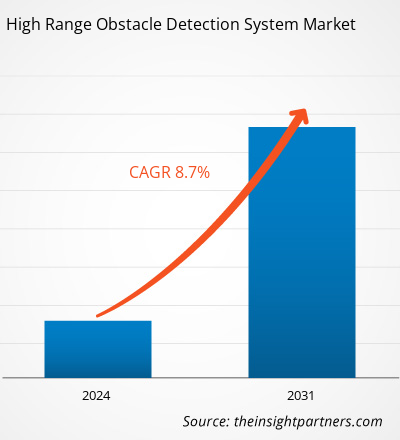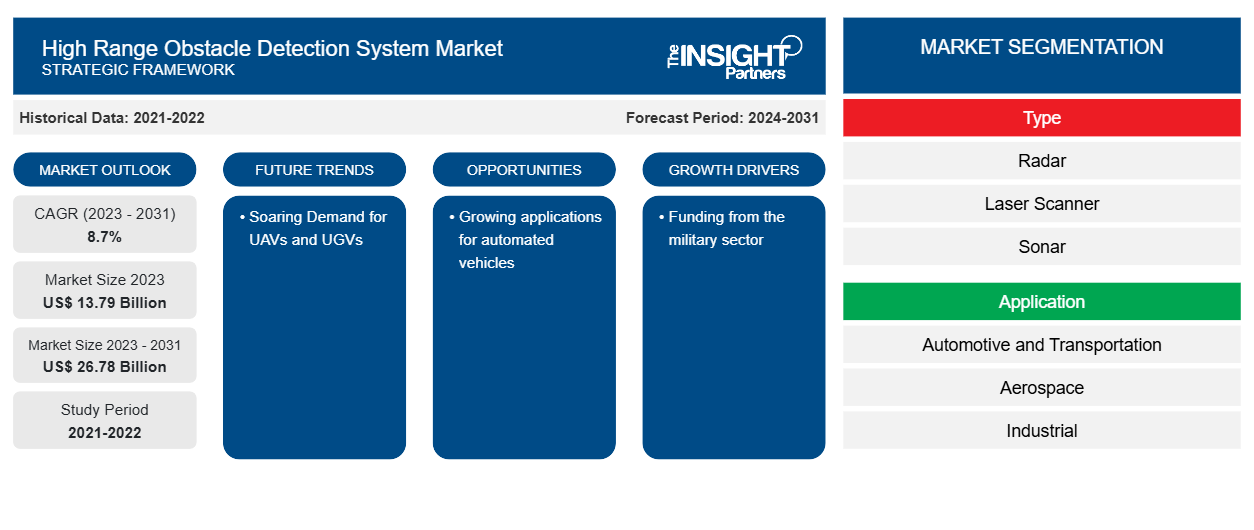Se prevé que el tamaño del mercado de sistemas de detección de obstáculos de alto alcance alcance los 26.780 millones de dólares estadounidenses en 2031, frente a los 13.790 millones de dólares estadounidenses en 2023. Se espera que el mercado registre una CAGR del 8,7 % entre 2023 y 2031. Es probable que la creciente demanda de sistemas de detección de obstáculos eficientes en el sector de la automoción y la adopción de la tecnología LiDAR en diversas industrias sigan siendo claves para las tendencias del mercado de sistemas de detección de obstáculos de alto alcance.
Análisis del mercado de sistemas de detección de obstáculos de alto alcance
Se espera que el mercado global de sistemas de detección de obstáculos de alto alcance se expanda rápidamente debido a su aplicación en una variedad de sectores industriales, incluidos los de la automoción, la robótica, la aeroespacial y la defensa. Algunos de los principales factores que impulsan el crecimiento del mercado global de sistemas de detección de obstáculos de alto alcance incluyen la creciente demanda de vehículos autónomos y una mayor necesidad de detección de colisiones. Se espera que los avances tecnológicos en sensores y componentes relacionados creen oportunidades significativas para los participantes del mercado.
Descripción general del mercado de sistemas de detección de obstáculos de alto alcance
La detección confiable de obstáculos de alto alcance es fundamental para que las plataformas de rápido movimiento y de seguridad crítica, como los autos autónomos, puedan responder a los peligros en tiempo real. Un sistema de detección de obstáculos de alto alcance detecta obstáculos como árboles y edificios a distancia. Funciona utilizando sensores como radares, cámaras y láseres para medir la altura y los objetos en el entorno y notificar al usuario cuando se detecta un obstáculo. Estos sistemas se utilizan en una variedad de aplicaciones, incluida la navegación de vehículos y aeronaves, la detección militar, la evitación de minas terrestres y otras.
Personalice este informe según sus necesidades
Obtendrá personalización en cualquier informe, sin cargo, incluidas partes de este informe o análisis a nivel de país, paquete de datos de Excel, así como también grandes ofertas y descuentos para empresas emergentes y universidades.
- Obtenga las principales tendencias clave del mercado de este informe.Esta muestra GRATUITA incluirá análisis de datos, desde tendencias del mercado hasta estimaciones y pronósticos.
Impulsores y oportunidades del mercado de sistemas de detección de obstáculos de alto alcance
Financiación del sector militar para favorecer el mercado
El sistema de detección de obstáculos de alto alcance es un sistema de detección sofisticado que utiliza tecnologías de radar y visión para detectar obstáculos y peligros a larga distancia. Se utiliza en aplicaciones militares, como drones, vehículos terrestres y barcos. Este sistema utiliza sensores avanzados que ayudan a detectar obstáculos en tiempo real. Esta tecnología avanzada ayuda a mejorar la eficiencia de los drones, los vehículos de superficie no tripulados (USV) y otros. Para el uso de esta tecnología en el sector militar, los actores del mercado reciben financiación de los militares para desarrollar soluciones técnicamente avanzadas. Por ejemplo, en diciembre de 2023, KEF Robotics recibió financiación del Departamento de Defensa de EE. UU. para desarrollar una solución de detección de obstáculos habilitada por IA para los drones atados del Ejército de EE. UU.USV), and others. For such use of this technology in the military sector, the market players are funded by military to develop technically advanced solutions. For instance, in December 2023, KEF Robotics received funding from the US Department of Defense to develop an AI-enabled obstacle detection solution for US Army tethered drones.
Crecientes aplicaciones para vehículos automatizados
Existe un mercado en crecimiento de vehículos automatizados y sistemas de conducción autónoma, ya que plantean un transporte más seguro y eficiente. Los vehículos automatizados generan la demanda de sistemas de detección de obstáculos, lo que a su vez fomenta la demanda de sistemas de detección de obstáculos de alto alcance para lograr una detección precisa de obstáculos. Con la adopción de esta solución, el vehículo detecta rápidamente los obstáculos y reacciona en consecuencia. Esta característica mejora la seguridad de los vehículos autónomos.
Análisis de segmentación del informe de mercado del sistema de detección de obstáculos de alto alcance
Los segmentos clave que contribuyeron a la derivación del análisis del mercado del sistema de detección de obstáculos de alto alcance son el tipo y la aplicación.
- Según el tipo, el mercado se segmenta en radar, escáner láser , sonar y lidar. Se espera que el segmento lidar crezca con la tasa de crecimiento anual compuesta más alta.
- Por aplicación, el mercado está segmentado en aplicaciones automotrices y de transporte, aeroespaciales, industriales, marinas y otras. El segmento de automoción y transporte tuvo una mayor participación de mercado en 2023.
Análisis de la cuota de mercado de los sistemas de detección de obstáculos de alto alcance por geografía
El alcance geográfico del informe de mercado del sistema de detección de obstáculos de alto alcance se divide principalmente en cinco regiones: América del Norte, Asia Pacífico, Europa, Medio Oriente y África, y América del Sur / América del Sur y Central.
Se espera que la región de Asia Pacífico crezca con la CAGR más alta. El mercado de detección de obstáculos de alto alcance está creciendo en la región con el aumento en el uso de robots industriales. La amplia aplicación de la detección de obstáculos de alto alcance en vehículos autónomos y drones fomenta aún más su crecimiento de mercado.
Perspectivas regionales del mercado de sistemas de detección de obstáculos de alto alcance
Los analistas de Insight Partners explicaron en detalle las tendencias y los factores regionales que influyen en el mercado de sistemas de detección de obstáculos de alto alcance durante el período de pronóstico. Esta sección también analiza los segmentos y la geografía del mercado de sistemas de detección de obstáculos de alto alcance en América del Norte, Europa, Asia Pacífico, Oriente Medio y África, y América del Sur y Central.

- Obtenga datos regionales específicos para el mercado de sistemas de detección de obstáculos de alto alcance
Alcance del informe de mercado del sistema de detección de obstáculos de alto alcance
| Atributo del informe | Detalles |
|---|---|
| Tamaño del mercado en 2023 | US$ 13,79 mil millones |
| Tamaño del mercado en 2031 | US$ 26,78 mil millones |
| CAGR global (2023 - 2031) | 8,7% |
| Datos históricos | 2021-2022 |
| Período de pronóstico | 2024-2031 |
| Segmentos cubiertos | Por tipo
|
| Regiones y países cubiertos | América del norte
|
| Líderes del mercado y perfiles de empresas clave |
|
Densidad de actores del mercado: comprensión de su impacto en la dinámica empresarial
El mercado de sistemas de detección de obstáculos de alto alcance está creciendo rápidamente, impulsado por la creciente demanda de los usuarios finales debido a factores como la evolución de las preferencias de los consumidores, los avances tecnológicos y una mayor conciencia de los beneficios del producto. A medida que aumenta la demanda, las empresas amplían sus ofertas, innovan para satisfacer las necesidades de los consumidores y aprovechan las tendencias emergentes, lo que impulsa aún más el crecimiento del mercado.
La densidad de actores del mercado se refiere a la distribución de las empresas o firmas que operan dentro de un mercado o industria en particular. Indica cuántos competidores (actores del mercado) están presentes en un espacio de mercado determinado en relación con su tamaño o valor total de mercado.
Las principales empresas que operan en el mercado de sistemas de detección de obstáculos de alto alcance son:
- BAE Systems plc
- Blickfeld GmbH
- Aeroespacial Collins
- Compañía: Honeywell International Inc.
- ifm electronic gmbh
- Livox®
Descargo de responsabilidad : Las empresas enumeradas anteriormente no están clasificadas en ningún orden particular.

- Obtenga una descripción general de los principales actores clave del mercado de sistemas de detección de obstáculos de alto alcance
Noticias del mercado y desarrollos recientes de sistemas de detección de obstáculos de alto alcance
El mercado de sistemas de detección de obstáculos de alto alcance
Se evalúa mediante la recopilación de datos cualitativos y cuantitativos a partir de investigaciones primarias y secundarias, que incluyen publicaciones corporativas importantes, datos de asociaciones y bases de datos. A continuación, se incluye una lista de los avances del mercado:
- En mayo de 2023, el Centro de Ingeniería de Bosch en Cluj anunció la instalación de un sistema de advertencia de colisión desarrollado por Bosch llamado Tram Forward Collision Warning (TFCW) en un tranvía que forma parte de la flota de la Compañía de Transporte Público de Cluj-Napoca (CTP). El sistema ayuda a los conductores de tranvía en situaciones críticas al proporcionar advertencias sonoras y visuales, mejorando así la seguridad de los conductores de tranvía, los pasajeros y otros participantes del tráfico. El sistema de advertencia de colisión de tranvía ayuda a los conductores en situaciones críticas al advertirles de manera oportuna sobre los obstáculos en las vías, especialmente en condiciones de tráfico congestionado o visibilidad reducida. Esto permite a los conductores evitar accidentes o reducir significativamente los daños. (Comunicado de prensa, 2023)
Informe de mercado sobre sistemas de detección de obstáculos de alto alcance: cobertura y resultados
El informe “Tamaño y pronóstico del mercado del sistema de detección de obstáculos de alto alcance (2023-2031)” proporciona un análisis detallado del mercado que cubre las siguientes áreas:
- Tamaño del mercado y pronóstico a nivel global, regional y nacional para todos los segmentos clave del mercado cubiertos bajo el alcance
- Dinámica del mercado, como impulsores, restricciones y oportunidades clave
- Principales tendencias futuras
- Análisis detallado de las cinco fuerzas de Porter y PEST y FODA
- Análisis del mercado global y regional que cubre las tendencias clave del mercado, los principales actores, las regulaciones y los desarrollos recientes del mercado.
- Análisis del panorama de la industria y de la competencia que abarca la concentración del mercado, el análisis de mapas de calor, los actores destacados y los desarrollos recientes
- Perfiles detallados de empresas
- Análisis histórico (2 años), año base, pronóstico (7 años) con CAGR
- Análisis PEST y FODA
- Tamaño del mercado, valor/volumen: global, regional y nacional
- Industria y panorama competitivo
- Conjunto de datos de Excel
Informes recientes
Testimonios
Razón para comprar
- Toma de decisiones informada
- Comprensión de la dinámica del mercado
- Análisis competitivo
- Información sobre clientes
- Pronósticos del mercado
- Mitigación de riesgos
- Planificación estratégica
- Justificación de la inversión
- Identificación de mercados emergentes
- Mejora de las estrategias de marketing
- Impulso de la eficiencia operativa
- Alineación con las tendencias regulatorias





















 Obtenga una muestra gratuita para - Mercado de sistemas de detección de obstáculos de alto alcance
Obtenga una muestra gratuita para - Mercado de sistemas de detección de obstáculos de alto alcance